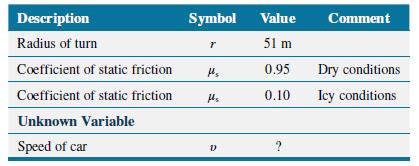Multiple-Concept Example 7 reviews the concepts that play a role in this problem. Car A uses tires
Question:
Multiple-Concept Example 7 reviews the concepts that play a role in this problem. Car A uses tires for which the coefficient of static friction is 1.1 on a particular unbanked curve. The maximum speed at which the car can negotiate this curve is 25 m/s. Car B uses tires for which the coefficient of static friction is 0.85 on the same curve. What is the maximum speed at which car B can negotiate the curve?
Concept Example 7
At what maximum speed can a car safely negotiate a horizontal unbanked turn (radius = 51 m) in dry weather (coefficient of static friction = 0.95) and icy weather (coeffi cient of static friction = 0.10)?
Reasoning
The speed υ at which the car of mass m can negotiate a turn of radius r is related to the centripetal force Fc that is available, according to Fc = mυ2/r (Equation 5.3). Static friction provides the centripetal force and can provide a maximum force fsMAX given by fsMAX = μsFN (Equation 4.7), in which μs is the coefficient of static friction and FN is the normal force. Thus, we will use the fact that Fc = fsMAX to obtain the maximum speed from Equation 5.3. It will also be necessary to evaluate the normal force, which we will do by considering that it must balance the weight of the car. Experience indicates that the maximum speed should be greater for the dry road than for the icy road.

Step by Step Answer:

Physics
ISBN: 9781119539636
11th Edition
Authors: John D. Cutnell, Kenneth W. Johnson, David Young, Shane Stadler





